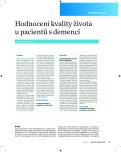Normocytic and macrocytic anemia in the elderly
Authors:
J. Kissová
Authors‘ workplace:
Oddělení klinické hematologie LF MU a FN Brno
Published in:
Geriatrie a Gerontologie 2014, 3, č. 4: 183-187
Category:
Review Article
Overview
Anemia is a common pathological condition in patients of older age. It is associated with a variety of complications, including increased risk of death, and therefore the adequate diagnosis and treatment is important. The most common causes of anemia in elderly are iron deficiency anemia, anemia of chronic disease, anemia in chronic kidney disease or „unexplained“ anemia. The present article summarizes the issues of diagnosis and differential diagnosis of normocytic and macrocytic anemia in the elderly.
Keywords:
anemia – normocytic anemia – macrocytic anemia – anemia of chronic disease – megaloblastic anemia
Sources
1. Nutritional anaemias. Report of a WHO scientific group. World Health Organ Tech Rep Ser 1968; 405: 5–37. Dostupné na http://whqlibdoc.who.int/trs/WHO_TRS_405.pdf.
2. Guralnik JM, Eisenstaedt RS, Ferrucci L et al.: Prevalence of anemia in persons 65 years and older in the United States: evidence for a high rate of unexplained anemia. Blood 2004; 104(8): 2263–2268.
3. Beghé C, Wilson A, Ershler WB: Prevalence and outcomes of anemia in geriatrics: a systematic review of the literature. Am J Med 2004; 116(Suppl 7A): 3S–10S.
4. Eisenstaedt R, Penninx BW, Woodman RC: Anemia in the elderly: current understanding and emerging concepts. Blood Rev 2006; 20(4): 213–226.
5. Tefferi A: Anemia in adults: a contemporary approach to diagnosis. Mayo Clin Proc 2003; 78(10): 1274–1280.
6. Cavill I, Auerbach M, Bailie GR et al.: Iron and the anaemia of chronic disease: a review and strategic recommendations. Current Medical research and Opinion 2006; 22(4): 731–737.
7. Buliková A: Anemie. In: Penka M, Buliková A. a kol. Neonkologická hematologie, 2. vydání, Praha: Grada Publishing 2009; 39–93.
8. Ershler WB, Keller ET: Age-associated increased interleukin-6 gene expression, late-life diseases, and frailty. Annu Rev Med 2000; 51: 245–270.
9. Čermák J: K diferenciální diagnostice a léčbě anemií. Remedia 2003; 13: 258–265.
10. Cumming RG, Mitchell P, Craig JC et al.: Renal impairment and anaemia in a population-based study of older people. Intern Med J 2004; 34(1–2): 20-23.
11. Pereira CA, Roscani, MG, Zanati SG et al.: Anemia, heart failure and evidence-based clinical management. Arq Bras Cardiol 2013; 101(1): 87–92.
12. Guralnik JM, Ershler WB, Schrier SL et al.: Anemia in the elderly: a public health crisis in hematology. Hematology Am Soc Hematol Educ Program 2005: 528–532.
13. Merchant AA, Roy, CN: Not so benign haematology: anaemia of the elderly. Br J Haematol 2012; 156(2): 173–185.
14. Hamilton MS, Blackmore S: Investigation of megaloblastic anaemia: cobalamin, folate and metabolite status. In: Bain B, Bates, I, Laffan MA et al. Dacie and Levis Practical Haematology 2012; 201–228.
15. Carmel R, Green R, Rosenblatt DS et al.: Update on cobalamin, folate, and homocysteine. Hematology Am Soc Hematol Educ Program 2003: 62–81.
16. Hoffbrand AV, Moss PAH: Megaloblastic anaemias and other macrocytic anaemias. In: Essential Haematology. Blackwell Publishing Ltd. 2011: 58–72.
Labels
Geriatrics General practitioner for adults Orthopaedic prostheticsArticle was published in
Geriatrics and Gerontology

2014 Issue 4
Most read in this issue
- Normocytic and macrocytic anemia in the elderly
- Dehydration in the old age
- Iron deficiency related anaemia and geriatric medicine
- Nutrition in the elderly
